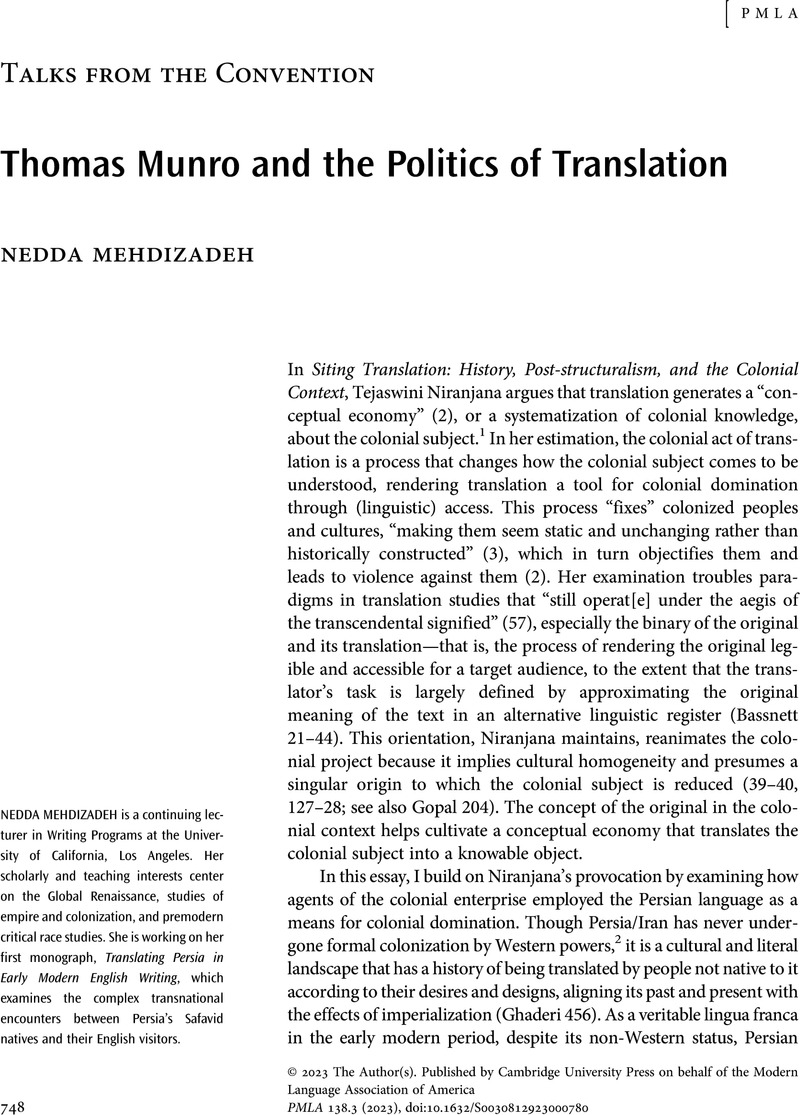No CrossRef data available.
Article contents
Thomas Munro and the Politics of Translation
Published online by Cambridge University Press: 12 September 2023
Abstract
An abstract is not available for this content so a preview has been provided. Please use the Get access link above for information on how to access this content.

- Type
- Talks from the Convention
- Information
- Copyright
- Copyright © 2023 The Author(s). Published by Cambridge University Press on behalf of the Modern Language Association of America
References
Works Cited
Babayan, Kathryn. “The Safavids in Iranian History (1501–1722).” The Oxford Handbook of Iranian History, edited by Daryaee, Touraj, Oxford UP, 2012, pp. 285–305.Google Scholar
Cheyfitz, Eric. “Translation, Transportation, Usurpation.” The Poetics of Imperialism: Translation and Colonization from The Tempest to Tarzan, Oxford UP, 1991, pp. 59–82.Google Scholar
Choksy, Jamsheed. “Zoroastrianism ii. Historical Review: From the Arab Conquest to Modern Times.” Encyclopedia Iranica, 22 Jan. 2015, iranicaonline.org/articles/zoroastrianism-02-arab-conquest-to-modern.Google Scholar
Clouston, W. A., translator. The Book of Sindibad; or, The Story of the King, His Son, the Damsel, and the Seven Vazirs. 1884.Google Scholar
“Copy in the Hand of Sir Thomas Munro of ‘The Mussulman and the Jew,’ a Persian MS, 1786.” Folger Shakespeare Library, Washington, DC, S.b.122. Manuscript.Google Scholar
Daryaee, Touraj. Introduction. The Oxford Handbook of Iranian History, edited by Daryaee, , Oxford UP, 2012, pp. 3–12.Google Scholar
Ghaderi, Farah. “Iran and Postcolonial Studies: Its Development and Current Status.” Interventions, vol. 20, no. 4, 2018, pp. 455–69.CrossRefGoogle Scholar
Gopal, Priyamvada. Review of Siting Translation: History, Post-structuralism, and the Colonial Context, by Tejaswini Niranjana. Modern Fiction Studies, vol. 39, no. 1, spring 1993, pp. 204–06. JSTOR, www.jstor.org/stable/26284404.CrossRefGoogle Scholar
Grier, Miles P. “Black/White.” Shakespeare/Text: Contemporary Readings in Textual Studies, Editing and Performance, edited by Bourne, Claire M. L., Bloomsbury Publishing, 2021, pp. 319–42.Google Scholar
Grogan, Jane. The Persian Empire in English Renaissance Writing, 1549–1622. Palgrave Macmillan, 2014.CrossRefGoogle Scholar
Hall, Kim F. Things of Darkness: Economies of Race and Gender in Early Modern England. Cornell UP, 1995.CrossRefGoogle Scholar
Hendricks, Margo, and Parker, Patricia. Women, ‘Race,’ and Writing in the Early Modern Period. Routledge, 1994.Google Scholar
Heng, Geraldine. The Invention of Race in the European Middle Ages. Cambridge UP, 2018.CrossRefGoogle Scholar
Hodgson, Marshall. The Venture of Islam: Conscience and History in a World Civilization. U of Chicago P, 1990, vol. 2.Google Scholar
Malone, Edmond, and Boswell, James. The Plays and Poems of William Shakespeare with the Corrections and Illustrations of Various Commentators: Comprehending A Life of the Poet and an Enlarged History of the Stage. Vol. 5, London, 1821.Google Scholar
Marshall, P. J. The Making and Unmaking of Empires: Britain, India, and America c. 1750–1783. Oxford UP, 2005.Google Scholar
Mehdizadeh, Nedda. “Cosmography and/in the Academy: Authorizing the Ideological Pathways of Empire.” Exemplaria, vol. 35, no. 1, pp. 66–89.CrossRefGoogle Scholar
Mehdizadeh, Nedda. “Robert Sherley and the Persian Habit.” England's Asian Renaissance, edited by Su Fang Ng and Carmen Nocentelli, U of Delaware P, 2021, pp. 55–78.Google Scholar
Ndiaye, Noémie. “Shakespeare, Race, and Globalization: Titus Andronicus.” The Cambridge Companion to Shakespeare and Race, edited by Thompson, Ayanna. Cambridge UP, 2021, pp. 158–74.CrossRefGoogle Scholar
Niranjana, Tejaswini. Siting Translation: History, Post-structuralism, and the Colonial Context. U of California P, 1992.CrossRefGoogle Scholar
Pratt, Mary Louise. Imperial Eyes: Travel Writing and Transculturation. Routledge, 1992.CrossRefGoogle Scholar
Ritchie, Fiona, and Sabor, Peter. Introduction. Shakespeare in the Eighteenth Century, Cambridge UP, 2012, pp. 1–20.CrossRefGoogle Scholar
Rivett, Sarah. Unscripted America: Indigenous Languages and the Origins of a Literary Nation. Oxford UP, 2017.Google Scholar
Singh, Julietta. Unthinking Mastery: Dehumanism and Decolonial Entanglements. Duke UP, 2018.CrossRefGoogle Scholar
Smith, Ian. Race and Rhetoric in the Renaissance: Barbarian Errors. Palgrave Macmillan, 2009.Google Scholar
Spivak, Gayatri Chakravorty. “The Politics of Translation.” The Translation Studies Reader, edited by Venuti, Lawrence, 3rd ed., Routledge, 2000, pp. 312–30.Google Scholar
Vaughn, Earnest V. “English Trading Expeditions into Asia under the Authority of the Muscovy Company (1557–1581).” Studies in the History of English Commerce in the Tudor Period, edited by Gerson, Armand J. et al., D. Appleton, 1912, pp. 123–214.Google Scholar


